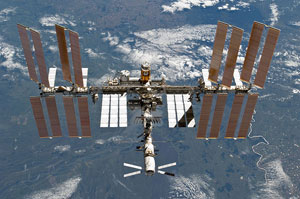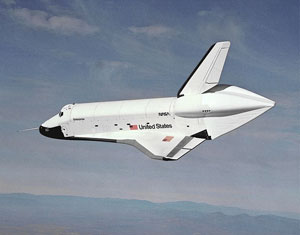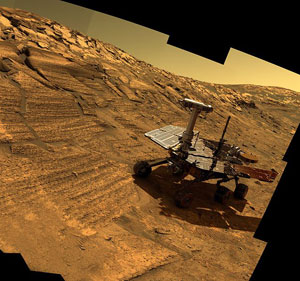ISS International Space Station

The International Space Station (ISS) is a habitable artificial satellite in low Earth orbit. It follows the Salyut, Almaz, Skylab and Mir stations as the ninth space station to be inhabited. The ISS is a modular structure whose first component was launched in 1998. Now the largest artificial body in orbit, it can often be seen at the appropriate time with the naked eye from Earth. The ISS consists of pressurised modules, external trusses, solar arrays and other components. ISS components have been launched by American Space Shuttles as well as Russian Proton and Soyuz rockets.
The ISS serves as a microgravity and space environment research laboratory in which crew members conduct experiments in biology, human biology, physics, astronomy, meteorology and other fields. The station is suited for the testing of spacecraft systems and equipment required for missions to the Moon and Mars.(Source: image and text wikipedia)
Space Shuttle

The Space Shuttle was a crewed, partially reusable low Earth orbital spacecraft operated by the U.S. National Aeronautics and Space Administration (NASA). Its official program name was Space Transportation System, taken from a 1969 plan for a system of reusable spacecraft of which it was the only item to be funded for development. The first of four orbital test flights occurred in 1981, leading to operational flights beginning in 1982. It was used on a total of 135 missions from 1981 to 2011, all launched from the Kennedy Space Center, Florida.
Major missions included launching numerous satellites, interplanetary probes, the Hubble Space Telescope (HST), conducting space science experiments, and constructing and servicing the International Space Station. Major components included the orbiters, recoverable boosters, external tanks, payloads, and supporting infrastructure. Five space-worthy orbiters were built; two were lost in mission accidents.


Mars Missions

The exploration of Mars has taken place over hundreds of years, beginning in earnest with the invention and development of the telescope since the 1600s. Increasingly detailed views of the planet from Earth inspired speculation about its environment and possible life – even intelligent civilizations – that might be found there. Probes sent from Earth beginning in the late 20th century have yielded a dramatic increase in knowledge about the Martian system, focused primarily on understanding its geology and possible habitability potential.
Engineering interplanetary journeys is very complicated, so the exploration of Mars has experienced a high failure rate, especially in earlier attempts. Roughly two-thirds of all spacecraft destined for Mars failed before completing their missions, and there are some that failed before their observations could begin. However, missions have also met with unexpected levels of success, such as the twin Mars Exploration Rovers operating for years beyond their original mission specifications.
Since 6 August 2012, there have been two rovers on the surface of Mars beaming signals back to Earth (Opportunity, and Curiosity of the Mars Science Laboratory mission), and three orbiters currently surveying the planet: Mars Odyssey, Mars Express, and Mars Reconnaissance Orbiter. (Source: images and text wikipedia)
Copyright Timelines Webdesign 2013 - 2020




